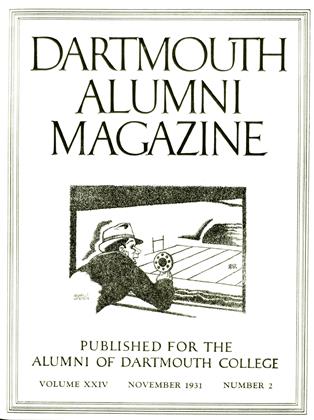When the game was over I looked back over the charts and came to the conclusion that the Holy Cross team of 1931 was a fine eleven just on account of this march that followed. For any team which sees the opening kickoff run back by the opponents to eventually result in a score and then turns the tables for a march of their own is a good team.
Holy Cross opened the attack up wide with a variety of line smashes and forward passes featuring Phil O'Connell, the great Crusader quarterback. The march was seventy yards with McCall and Frigard transformed into defensive players and making most of the tackles behind an uncertain line. The last play was a forward pass, O'Connell to Murray, which went wide over the Purple left end for the touchdown, and Griffin's goal tied the score.
The drama of the game was packed into the second period, for Dartmouth won and saved the game almost on the opening play. Morton opened up his passing attack, and drove the team sixty yards for the touchdown. In a game in which the Green was doped to be conservative the spectators were treated to a Dartmouth team throwing lateral and forward passes with abandon which pushed the Crusaders slowly but surely back to the shadow of their goal.
The last play saw Morton crash left tackle for the winning touchdown.
Then Holy Cross came back with a bang when a fellow named Rovenski was sent in for Capt. O'Connell.
Starting at exactly midfield, Holy Cross ploughed through the Dartmouth line with Rovenski as the aggressor and the attack catapulted to the three-yard line. A tie score seemed imminent, but to the eternal credit of Dartmouth, four times in a row Holy Cross gained nary an inch.
The rest of the game was one of those ding dong affairs in which neither team is superior, but out of the tangled mess of ideas emanating from that game, many things were apparent.
 View Full Issue
View Full Issue
More From This Issue
-
 Article
ArticleThe Class of Nineteen Thirty-five
November 1931 By E. Gordon Bill -
 Sports
SportsFootball at Dartmouth in the Year 1931
November 1931 By Sidney C. Hayward -
 Class Notes
Class NotesCLASS of 1910
November 1931 By "Hap' Hinman -
 Class Notes
Class NotesCLASS of 1930
November 1931 By Albert I. Dickerson -
 Class Notes
Class NotesCLASS of 1926
November 1931 By J. Branton Wallace -
 Class Notes
Class NotesCLASS of 1929
November 1931 By Frederick William Andres
Sports
-
 Sports
SportsCOLLEGE BOXING CHAMPIONS CHOSEN IN TOURNAMENT
APRIL 1928 -
 Sports
SportsBlaik Selects Coaches
May 1934 -
 Sports
SportsAthlete of the Month
June 1939 -
 Sports
SportsSWIMMING
April 1950 By Francis E. Merrill '26 -
 Sports
SportsFOOTBALL
June 1950 By Francis E. Merrill '26 -
 Sports
SportsWith PHIL SHERMAN
JANUARY 1932 By H. H. Hubbard '32

